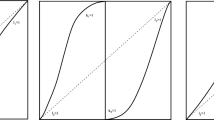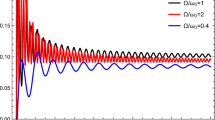Abstract
The quasistationary decay rate of a metastable state, RD, often is interpreted as the inverse of the average lifetime of this state, τa. There are two ways for finding the rate: to evaluate it using one of the approximate Kramers formulas or to extract the rate RD from numerical modeling. We study quantitatively to what extent the inverse decay rate can be identified with the mean lifetime and to what extent the approximate and numerical quasistationary rates agree with each other. This is done for the values of dissipation strength covering 4 orders of magnitude. Both the numerical rate and the average lifetime are obtained from computer modeling of the decay process using the stochastic differential equations for the phase space diffusion. It is shown that at lower temperature, the numerical rate is in agreement with the inverse lifetime whereas at weak friction and high temperature, τa exceeds \( {R}_D^{-1} \) by up to 50%. The Kramers formula for the decay rate at strong friction is found to be in a good agreement with the dynamical rate deviating typically by 5%. For weak friction, the agreement is substantially worse: the difference varies from 20% to a factor of 2.




Similar content being viewed by others
References
P. Talkner, P. Hänggi (eds.), New Trends in Kramers’ Reaction Rate Theory (Springer, Berlin, 2012)
H.-X. Zhou, Rate theories for biologists. Q. Rev. Biophys. 43, 219–293 (2010)
I.I. Gontchar, M.V. Chushnyakova, N.E. Aktaev, A.L. Litnevsky, E.G. Pavlova, Disentangling effects of potential shape in the fission rate of heated nuclei. Phys. Rev. C 82, 064606 (2010)
R.E. Lagos, T.P. Simões, Charged Brownian particles: Kramers and Smoluchowski equations and the hydrothermodynamical picture. Phys. A Stat. Mech. Its Appl. 390, 1591–1601 (2011)
A. Rosas, I.L.D. Pinto, K. Lindenberg, Kramers’ rate for systems with multiplicative noise. Phys. Rev. E 94, 012101 (2016)
C.-C. Chien, S. Kouachi, K.A. Velizhanin, Y. Dubi, M. Zwolak, Thermal transport in dimerized harmonic lattices: exact solution, crossover behavior, and extended reservoirs. Phys. Rev. E 95, 012137 (2017)
M.V. Chushnyakova, I.I. Gontchar, Thermal decay of a metastable state: influence of rescattering on the quasistationary dynamical rate. Phys. Rev. E 97, 032107 (2018)
G. Hummer, A. Szabo, Kinetics from nonequilibrium single-Molecule pulling experiments. Biophys. J. 85, 5–15 (2003)
O.K. Dudko, G. Hummer, A. Szabo, Intrinsic rates and activation free energies from single-molecule pulling experiments. Phys. Rev. Lett. 96, 108101 (2006)
M. Abkenar, T.H. Gray, A. Zaccone, Dissociation rates from single-molecule pulling experiments under large thermal fluctuations or large applied force. Phys. Rev. E 95, 042413 (2017)
D. Hilscher, H. Rossner, Dynamics of nuclear fission. Ann. Phys. (Paris). 17, 471-552 (1992)
P. Paul, M. Thoennessen, Fission time scales from giant dipole resonances. Annu. Rev. Nucl. Part. Sci. 44, 65–108 (1994)
K. Mazurek, C. Schmitt, P.N. Nadtochy, A.V. Cheredov, Going beyond statistical models for fission in the Businaro-Gallone region. Phys. Rev. C 94, 064602 (2016)
C. Eccles, S. Roy, T.H. Gray, A. Zaccone, Temperature dependence of nuclear fission time in heavy-ion fusion-fission reactions. Phys. Rev. C 96, 054611 (2017)
I.I. Gontchar, M.V. Chushnyakova, Comment on “Temperature dependence of nuclear fission time in heavy-ion fusion-fission reactions”. Phys. Rev. C 98, 029801 (2018)
H.A. Kramers, Brownian motion in a field of force and the diffusion model of chemical reactions. Physica 7, 284–304 (1940)
I.I. Gonchar, G.I. Kosenko, Is the Kramers formula applicable for describing the decay of highly excited nuclear systems? Sov. J. Nucl. Phys. 53, 133-142 (1991)
A.V. Karpov, P.N. Nadtochy, E.G. Ryabov, G.D. Adeev, Consistent application of the finite-range liquid-drop model to Langevin fission dynamics of hot rotating nuclei. J. Phys. G Nucl. Part. Phys. 29, 2365–2380 (2003)
I.I. Gontchar, M.V. Chushnyakova, Thermal decay rate of a metastable state with two degrees of freedom: dynamical modelling versus approximate analytical formula. Pramana J. Phys. 88, 90 (2017)
H. Risken, T. Frank, The Fokker-Planck Equation, 2nd edn. (Springer-Verlag, Heidelberg, 1996)
P.E. Kloeden, E. Platen, Numerical Solution of Stochastic Differential Equations (Springer-Verlag, Heidelberg, 1992)
P. Fröbrich, G.-R. Tillack, Path-integral derivation for the rate of stationary diffusion over a multidimensional barrier. Nucl. Phys. A 540, 353–364 (1992)
I.I. Gontchar, A.E. Gettinger, L.V. Guryan, W. Wagner, Multidimensional dynamical-statistical model for describing the fission of excited nuclei. Phys. At. Nucl. 63, 1688–1708 (2000)
P.N. Nadtochy, A. Kelić, K.-H. Schmidt, Fission rate in multi-dimensional Langevin calculations. Phys. Rev. C 75, 064614 (2007)
M. Büttiker, E.P. Harris, R. Landauer, Thermal activation in extremely underdamped Josephson-junction circuits. Phys. Rev. B 28, 1268–1275 (1983)
S. Arrhenius, Zeitschrift Für Phys. Chemie 4, 226 (1889)
O. Edholm, O. Leimar, The accuracy of Kramers’ theory of chemical kinetics. Phys. A Stat. Mech. Its Appl. 98, 313–324 (1979)
P. Grangé, L. Jun-Qing, H.A. Weidenmüller, Induced nuclear fission viewed as a diffusion process: transients. Phys. Rev. C 27, 2063–2077 (1983)
I.I. Gontchar, N.E. Aktaev, Importance of the relaxation stage for adequate modeling of nuclear fission accompanied by light particle emission. Phys. Rev. C 80, 044601 (2009)
Author information
Authors and Affiliations
Corresponding author
Additional information
Publisher’s Note
Springer Nature remains neutral with regard to jurisdictional claims in published maps and institutional affiliations.
Rights and permissions
About this article
Cite this article
Chushnyakova, M.V., Gontchar, I.I. Precision Numerical Modeling of the Decay of a Metastable State at High Temperatures. Braz J Phys 49, 587–593 (2019). https://doi.org/10.1007/s13538-019-00671-8
Received:
Published:
Issue Date:
DOI: https://doi.org/10.1007/s13538-019-00671-8




